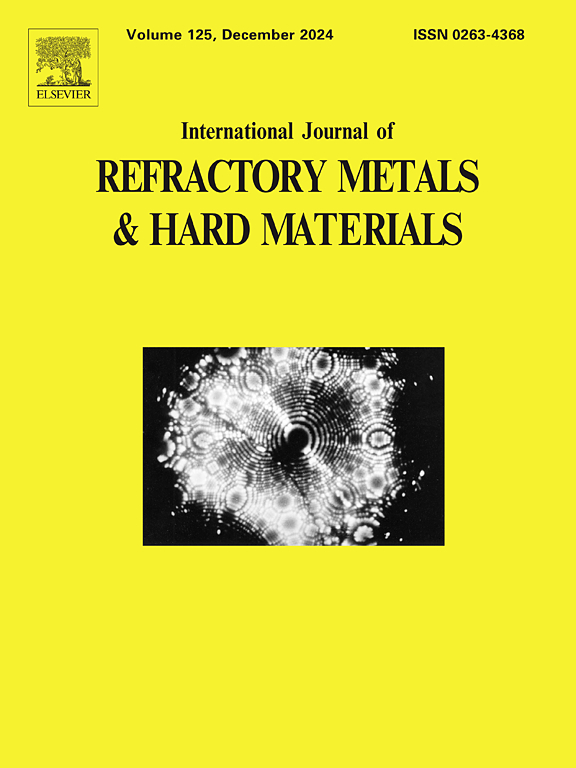Investigation of the microstructure and properties of a ZrC-reinforced TZM molybdenum alloy
IF 4.2
2区 材料科学
Q2 MATERIALS SCIENCE, MULTIDISCIPLINARY
International Journal of Refractory Metals & Hard Materials
Pub Date : 2025-04-14
DOI:10.1016/j.ijrmhm.2025.107188
引用次数: 0
Abstract
TZM-ZrC composites with different particle content were produced by high-energy ball milling and discharge plasma sintering technology. The density, microstructure and phase composition of the composites with different particle content were investigated. The microhardness and compressive strength at room and high temperature were tested. The strengthening mechanism was explored. The grain size and density of the composites gradually decrease as the ZrC content increase. The addition of ZrC particles provides C element to the matrix, and in situ reacts with the matrix Mo to form Mo2C and ZrC0.7. The generated reinforced phase and the unreacted stable carbide particles coexist in the grain and at the grain boundaries of the Mo matrix, which inhibit the growth of the grains. The average microhardness of TZM-ZrC composites reaches 670.66 HV, and the compressive strength at room temperature and high temperature (600 °C) is about 2200 MPa and 2000 MPa when the ZrC particle content is 10 %. The excellent mechanical properties and thermal stability of the TZM-ZrC composites are attributed to a synergistic effect of nano-scale dispersion strengthening of ZrC particles and fine-grain strengthening. The study can be used to develop other refractory alloys that have both high strength and high thermal stability for high-temperature applications.
研究 ZrC 增强 TZM 钼合金的微观结构和性能
采用高能球磨和放电等离子烧结技术制备了不同颗粒含量的TZM-ZrC复合材料。研究了不同颗粒含量的复合材料的密度、显微组织和相组成。测试了合金的室温和高温显微硬度和抗压强度。探讨了强化机理。随着ZrC含量的增加,复合材料的晶粒尺寸和密度逐渐减小。ZrC颗粒的加入为基体提供了C元素,并与基体Mo原位反应生成Mo2C和ZrC0.7。生成的增强相和未反应的稳定碳化物颗粒同时存在于Mo基体的晶界和晶粒中,抑制了晶粒的生长。当ZrC颗粒含量为10%时,TZM-ZrC复合材料的平均显微硬度达到670.66 HV,室温和高温(600℃)抗压强度分别约为2200 MPa和2000 MPa。ZrC复合材料具有优异的力学性能和热稳定性,这是由于ZrC颗粒的纳米级分散强化和细晶粒强化的协同作用。该研究可用于开发其他具有高强度和高热稳定性的高温应用的耐火合金。
本文章由计算机程序翻译,如有差异,请以英文原文为准。
求助全文
约1分钟内获得全文
求助全文
来源期刊
CiteScore
7.00
自引率
13.90%
发文量
236
审稿时长
35 days
期刊介绍:
The International Journal of Refractory Metals and Hard Materials (IJRMHM) publishes original research articles concerned with all aspects of refractory metals and hard materials. Refractory metals are defined as metals with melting points higher than 1800 °C. These are tungsten, molybdenum, chromium, tantalum, niobium, hafnium, and rhenium, as well as many compounds and alloys based thereupon. Hard materials that are included in the scope of this journal are defined as materials with hardness values higher than 1000 kg/mm2, primarily intended for applications as manufacturing tools or wear resistant components in mechanical systems. Thus they encompass carbides, nitrides and borides of metals, and related compounds. A special focus of this journal is put on the family of hardmetals, which is also known as cemented tungsten carbide, and cermets which are based on titanium carbide and carbonitrides with or without a metal binder. Ceramics and superhard materials including diamond and cubic boron nitride may also be accepted provided the subject material is presented as hard materials as defined above.

 求助内容:
求助内容: 应助结果提醒方式:
应助结果提醒方式:


